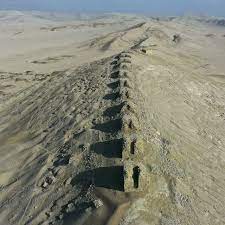
CASMA (Peru), July 27 (NNN-AGENCIES) — A 2,300-year-old solar observatory in Peru, a structure of 13 stone towers built atop a hill and used as a calendar, has been declared a UNESCO World Heritage site.
The Chankillo observatory, built by an ancient civilization about two millennia before the ascent of another well-known Sun cult — the Inca empire — allowed for remarkably accurate astronomical observations, according to recent studies.
The walled, hilltop ruins some 400 kilometers north of Lima had long puzzled scientists.
Then in 2007, a study in the journal Science proposed the sequence of towers erected between 200 and 300 BC “marked the summer and winter solstices” and that Chankillo “was in part a solar observatory.”
Peruvian archaeologist Ivan Ghezzi, who co-authored that study with British colleague Clive Ruggles, said the towers, erected “with great precision,” were placed to mark different positions of the Sun “and therefore mark exact dates.”
Their purpose was to time with astonishing accuracy the months, solstices and equinoxes — the planting and harvesting seasons and religious holidays.
The structure works like a giant clock, marking the passage of time over the span of a year.
“Chankillo is a masterpiece of ancient Peruvians. A masterpiece of architecture, a masterpiece of technology and astronomy. It is the cradle of astronomy in America,” Ghezzi said on a visit to the site.
It was also likely a place of Sun worship.
Sites to the east and west of the towers feature the remains of objects used for ritual sacrifices.
The observatory and its ceremonial appendages were protected by fortress walls made of stone, mud and tree trunks.
The complex spans some 5,000 hectares, but only about one percent has been studied, said Ghezzi.
Last year, the coronavirus epidemic paralyzed archaeological excavations in Peru, as elsewhere, and abandoned many sites containing priceless pre-Columbian objects to the mercy of looters, who sell to the black market.
Chankillo was among the sites invaded; not by thieves but by nearby farmers who have long looked to expand their land and who capitalized on the lack of control to plant crops within the borders of the site.
Peru has 12 other sites on the UNESCO World Heritage list, including the Inca citadel of Machu Picchu.
Chankillo was added to the list at the 44th session of the World Heritage Committee, held online and chaired from Fuzhou in China. It added four more sites in Latin America, including a tropical garden “living work of art” developed by landscape architect Roberto Burle Marx in Brazil, a modernistic church complex by engineer Eladio Dieste in Uruguay, the Chinchorro mummies of Chile and Mexico’s Tlaxcala cathedral. — NNN-AGENCIES





